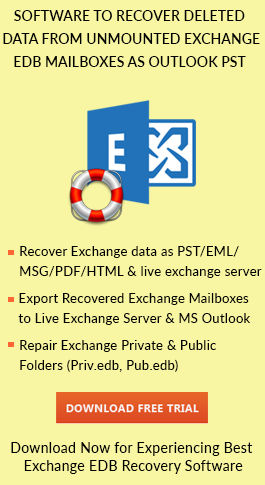How to Resolve Exchange Dirty Shutdown Error
Exchange server is a mail server developed by Microsoft. The latest versions are Microsoft Exchange Server 2016/2013/2010/2007. In combination with MS Outlook, Exchange Server is widely used by many Organisations to have an effective business communication. If the user wants the Exchange server to start normally then the transaction logs must be committed properly. If it is not shutdown properly, then it may lead to Exchange Dirty Shutdown which would effect the Exchange log files in the worst manner. Thus resolving this issue is very important for the smooth working of Exchange server.
Exchange Server Databases
MS exchange server 2007 supports up to 50 databases per server so that it can be mounted and dismounted independently and can be organized into up to 50 groups. Each Exchange 2010 database consists of the database file, .edb, a transaction log stream, .log, and a checkpoint file, .chk.
Transaction logs and Checkpoint files
Transaction log records all the changes that have been committed in the in-memory database. Exchange 2010 maintains a single set of transaction log files for each database. The transaction logs play an important role in backup and recovery operations. The transaction log files for an individual database record all the transactions performed on the database. Records of the transactions are written to the transaction logs before they are made in the database itself to ensure that the entire committed transactions can be recovered in the event of a database failure. Checkpoint files record the logged transactions that have been written to the on-disk database files. Because the checkpoint file records the transactions that are already in the on-disk database image, the Exchange store just has to replay transactions that occurred after the checkpoint. Depending on the time period between backups, this can greatly decrease the number of transactions that have to be replayed into the database in case of a system failure. Transaction logs and Checkpoint files are maintained to prevent data loss.
What is Exchange Dirty Shutdown
A “Dirty Shutdown state” happens when the information store have not been closed in a proper manner. This may be due to power outage or power surges or any other action that might cause the server to shutdown improperly. In-depth, when the log files are loaded into the cache memory before being committed to the information store, then it marks JET engine as dirty. And, if a system is shutdown in this condition intentionally or unintentionally, then it displays exchange dirty shutdown error. The user must make sure that the data in the transaction log is committed to the database files. When the server starts, at first it checks the state of the database. If the log files are not committed to the database, ie., if it is in the attached state, then it must be in a dirty shutdown state. Therefore, to have a smooth shutdown, make sure the log files are detached from the database.
How to Check for Dirty Shutdown
Login to the Exchange server that you want to check, then follow the steps given below:
1. Click Start, and then click Run.
2. In the Open box, type CMD, and then click OK.
3. Switch to the C:\Program Files\ExchSrvr\Bin folder, type one of the following commands (as appropriate to your situation), and then press ENTER:
4. Type in eseutil /mh
Find State: when you have “Dirty Shutdown” it will show “State: Dirty Shutdown”.
How to Resolve the Exchange Dirty Shutdown Error
Manual Method: When a dirty shutdown state occurs, the MS Exchange itself have a component that will try to soft-recover itself back to a clean state. The steps for the same are:
1. Run the eseutil /p from the BIN folder and repaired both the priv1.edb and pub1.edb files.
2. Delete the log and chk files.
3. Run a defrag on the stores . eseutil /d
4. Run ISIN teg (ISIN teg -s server name -fix -test all tests) from the bin folder.
5. Mount the stores.
Limitations of Manual Method
There are some drawbacks in using the manual method:
1. Highly corrupted data may not be recovered completely
2. Time consuming
3. Chances of data loss
Expert Solution for Exchange Dirty Shutdown Repair
Since effective Dirty Shutdown recovery is difficult using the manual method, users have the option to chose an automated solution to handle Exchange Shutdown error. EDB to PST Converter is one such Expert solution which provides a quick and easy recovery from Exchange Shutdown error.
Conclusion
MS Exchange server is widely used by many organizations. There may be situations when the users will have to face the Exchange Dirty Shutdown Error. So, it is necessary to understand the solutions to this problem. Manual methods are available for the recovery, but it may not be much effective. In order to overcome all these issues, an expert solution is available for the Exchange dirty shutdown Error.
